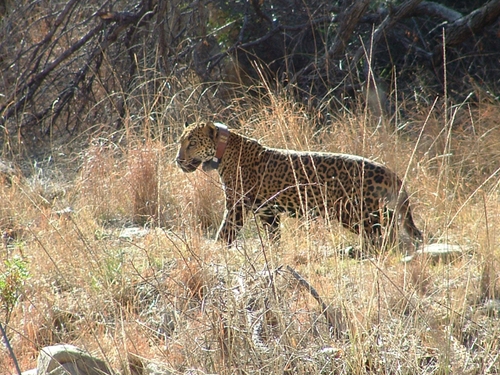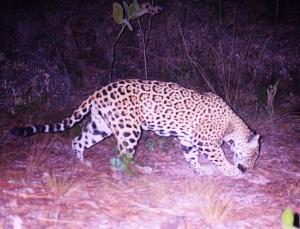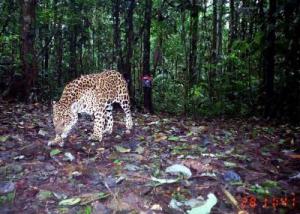
March 4, 2009

+++7:05 PM update
A Phoenix Zoo veterinarian who treated a euthanized jaguar says the animal had kidney disease, likely aggravated by the stress of being captured and tranquilized.
Zoo executive vice president Dean Rice says initial necropsy results show that the big cat’s kidneys weren’t working properly. The animal was 15 or 16 years old.
Rice says the stress of being caught inadvertently in a snare trap on Feb. 18 and then being tranquilized on two occasions would have aggravated the kidney problems.
++++
The recent news of the first jaguar (Panthera onca) captured in decades in Arizona has a sad update. The feline (shown above), as you will recall, was caught southwest of Tucson, then collared, and released. (More here.)
On March 2nd, this same Arizona jaguar was recaptured and sent to the Phoenix zoo for medical treatment. Then the jaguar was euthanized, that is killed, at the zoo because it was said to have experienced kidney failure.
According to the Arizona Daily Star, wildlife officials said the health of the animal was in jeopardy, and then they later released the kidney info.
The media account is contoured:
A wildlife veterinarian on Sunday was sent by the state to locate the jaguar to assess its condition. Data immediately after the cat’s capture indicated that the animal was doing well.
It was initially traveling more than three miles a day. However, more recent data showed it cutting back on its movements and a reduced amount of foraging over the past three days.
Officials said it was not immediately known if the capture of the jaguar was a factor in its kidney failure.
Veterinarians on Monday determined the cat was in severe and unrecoverable kidney failure.
State game and fish says the decision was made in consultations between the Arizona Game and Fish Department, the U.S. Fish and Wildlife Service and the Phoenix Zoo.
The cat was brought to the Phoenix Zoo earlier Monday after a game and fish team recaptured it.
Zoo veterinarians conducted lab work and physical exams to evaluate the animal and discovered the source of the cats deteriorating condition.
Deputy Director of the Arizona Game and Fish Department Gary Hovatter says it’s an “unfortunate and disappointing situation.”
You will note that during February 2009, there has been a rash of news released about jaguar recovery in the New World. I predict we have not heard the last of these feline stories.

The Tucson jaguar, February 2009.

The central Mexican jaguar, photo released February 2009.

The Ecuador jaguar, photo released February 2009.
About Loren Coleman
Loren Coleman is one of the world’s leading cryptozoologists, some say “the” leading living cryptozoologist. Certainly, he is acknowledged as the current living American researcher and writer who has most popularized cryptozoology in the late 20th and early 21st centuries.
Starting his fieldwork and investigations in 1960, after traveling and trekking extensively in pursuit of cryptozoological mysteries, Coleman began writing to share his experiences in 1969. An honorary member of Ivan T. Sanderson’s Society for the Investigation of the Unexplained in the 1970s, Coleman has been bestowed with similar honorary memberships of the North Idaho College Cryptozoology Club in 1983, and in subsequent years, that of the British Columbia Scientific Cryptozoology Club, CryptoSafari International, and other international organizations. He was also a Life Member and Benefactor of the International Society of Cryptozoology (now-defunct).
Loren Coleman’s daily blog, as a member of the Cryptomundo Team, served as an ongoing avenue of communication for the ever-growing body of cryptozoo news from 2005 through 2013. He returned as an infrequent contributor beginning Halloween week of 2015.
Coleman is the founder in 2003, and current director of the International Cryptozoology Museum in Portland, Maine.
Filed under Alien Big Cats, Breaking News, Cryptotourism, CryptoZoo News, Cryptozoologists, Cryptozoology, Mystery Cats, Obituaries